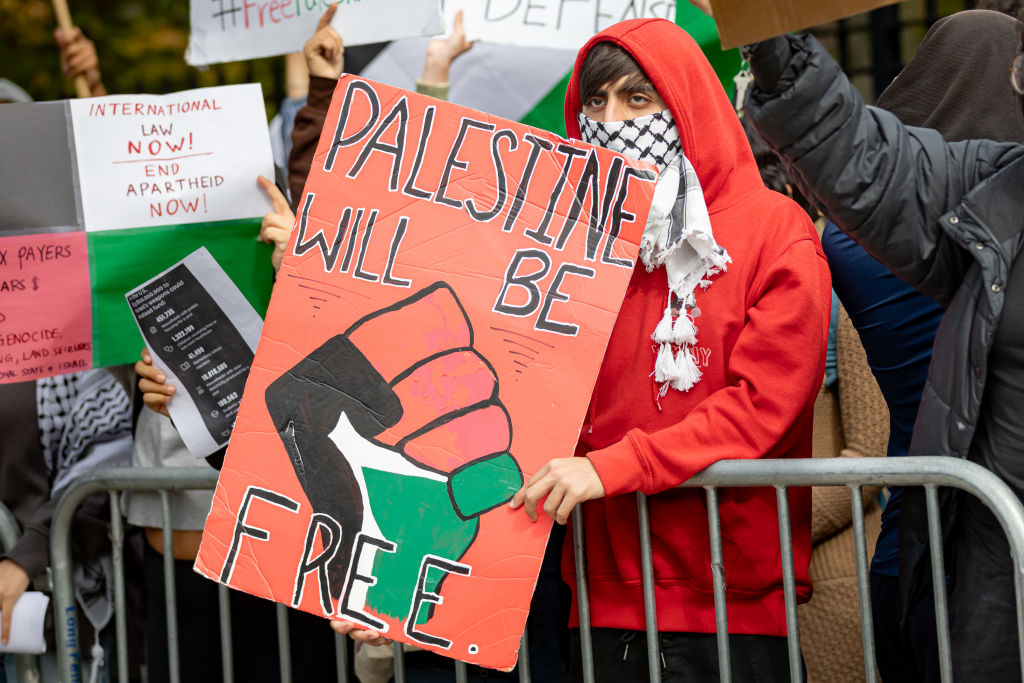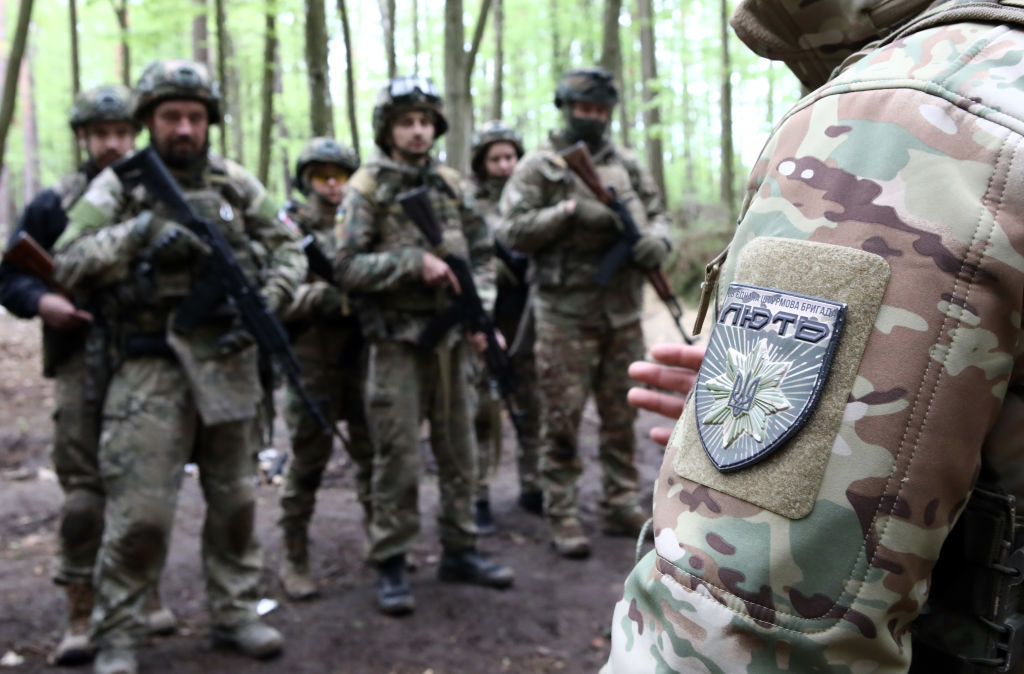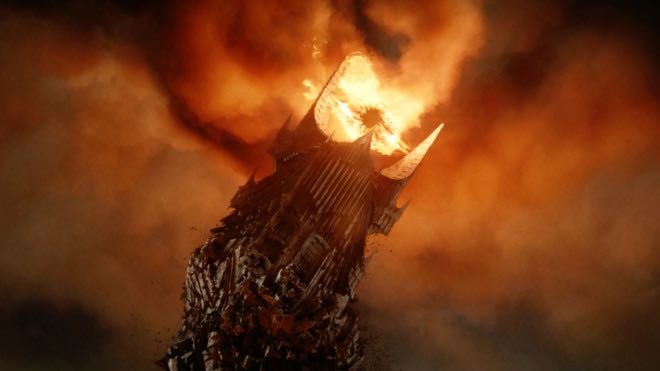The Biden administration seeks to impose a radical ideology on campuses.
Higher Ed Support for Hamas Exposes Disdain for America

Blame the universities for rising antisemitism.
This piece was originally published at TomKlingenstein.com.
If you don’t like the pro-Hamas demonstrations by American college students, then you won’t like American higher education, which is the garden in which these flowers were grown.
Within hours of the atrocities committed by Hamas operatives who invaded Israel on October 7, groups of American college students had organized to express their support for the terrorists. This caught many Americans by surprise. How could college students at some of America’s best universities sympathize with the perpetrators of gruesome attacks on unarmed civilians?
The surprise, however, was not universal. Those of us who pay close attention to American higher education were well aware of the rising tide of antisemitism on many campuses, and aware as well of the anger that these institutions had honed against Israel and the sympathies they had cultivated for Palestinian radicals. College officials were likewise aware that, among the students enrolled in their institutions, a significant number are affiliated with factions that loathe Israel, support Palestinian “resistance,” and are well-organized practitioners of public protest. Some college presidents initially issued mealy-mouthed disapproval or offered criticisms of both Hamas and Israel as equally at fault. After finding their equivocations poorly received, they issued new statements that were sometimes sterner about Hamas, but often continued to chastise Israel as well.
Some college presidents did forthrightly condemn Hamas and express strong support for Israel. At the end of October, a coalition founded by 16 college presidents issued a statement titled, “We Stand Together with Israel Against Hamas.” That statement eventually collected over 100 signatories.
But the larger academic scene lacks such common sense.
Boycotts
The anti-Israel factions, of course, are not limited to students. The professional association of the discipline, the American Anthropological Association (AAA), to which I have belonged for more than 40 years, in July adopted a resolution to boycott Israeli academic institutions on the grounds that “the Israeli state operates an apartheid regime from the Jordan River to the Mediterranean Sea.” The resolution garnered 71 percent of the votes.
This result does not mean that 71 percent of American anthropologists are antisemites. But it means the discipline is now what might be called antisemitic adjacent. The grievances upon which the resolution was based—disputes over territory, legal rights, immigration, economic opportunities, and religious practices—could be framed against almost every nation or even tribal group in the whole world. They are endemic among humanity. And as best we can tell, they have been since time immemorial.
These enmities, ancient and modern, do humanity little credit if we wish to judge ourselves by the criteria of the U.N.’s Universal Declaration of Human Rights, Kant’s categorical imperative, or the Sermon on the Mount. But supporters of the AAA boycott of Israel were not invoking lofty universalist principles or showing any inclination to apply them elsewhere. Uyghurs, Armenians, Rohingya, Romas, and a thousand other oppressed minorities will have to await their turn.
This academic teapot tempest shines a light on contemporary American antisemitism, which has its own distinct character. In America, antisemitism often disguises itself as something high-minded. It is not hatred of Jews per se, but criticism of the policies of the state of Israel, and can therefore be called “anti-Zionism,” which supposedly differs from antisemitism as much as butterflies differ from the Kerrygold Pure Irish product.
The distinction permits, for example, many progressive American Jews to support the enemies of Israel without experiencing the cognitive dissonance that would come from facing the reality that they support people who actively seek their own annihilation. It also allures large numbers of mostly young Americans enamored by the ideals of peace and justice, but who shun the notion that they are lending support to the proponents of racial genocide, or at a softer level, ethnic cleansing.
Hamas for one is perfectly open about its desire—as expressed on October 7—to eradicate Israel as a nation and to kill Jewish people wherever they are found. But anti-Zionism as a doctrine makes room for profound anger of Palestinians in light of “all they have suffered.” The American anti-Zionist who favors “peace” and “justice” somehow calculates that, once the injustices have been addressed, the Muslim radicals will settle down to some kind of mutual accommodation with the people they have been seeking to destroy.
This is to say, that “anti-Zionism” is a self-deluding from of antisemitism for some. For others, it is just effective marketing. If a group’s true goal is to destroy Israel and to kill the Jews, it is helpful to have a term that captures the imagination of people who would be repelled by that agenda but who could assist in the component project of undermining the legitimacy of the state of Israel.
The American Anthropology Association is only the most recent academic association to endorse a boycott of Israel. The Asian Studies Association voted for such a boycott in 2013, followed by the American Studies Association. The Boycott, Divestment, Sanction (BDS) movement attempts to recruit from many more sectors of society than just academia but American academe has been its primary focus.
BDS was founded in 2004 in Ramallah, but it currently operates in a semi-autonomous manner in the U.S. through several subsidiary organizations, the best known of which is Students for Justice in Palestine (SJP). My organization, the National Association of Scholars, published a detailed study of BDS earlier this year, The Company They Keep: Organizational and Economic Dynamics of the BDS Movement, which provides a roadmap to how BDS entwined itself with American higher education.
But why are American academics and American college students so drawn to an antisemitic movement, to the point at which they find it hard to criticize, let alone condemn the barbarities committed by Hamas?
Many Answers
Since the beginning of the pro-Hamas protests, I have been keeping close track of the responses by American observers of the academic scene. I wrote my own on the first day of the protests, “Higher Education’s Coddling of Hamas,” which said in part:
…we at NAS are aware that American higher education has become an institution that fosters disdain for America and its traditional allies, especially Israel. Many leaders of our colleges and universities insist on the “global” character of their institutions. This means in part scorn for the “nation state” and for “nationalism,” and Israel stands out as an exemplar of both.
Our universities eagerly seek out relations with America’s adversaries and cultivate among their students a fatuous regard for Third World states and non-Western cultures. They nurture the illusion that people who experienced the imposition of Western colonialism are somehow morally entitled to compensation, including violent dispossession of those they hold responsible for “oppression.”
I have as of this writing a collection of 71 published articles offering various explanations for the new explosion of antisemitism on campus, the alignment of a significant number of college students with Hamas, and the lameness of response by academic authorities. It would be a large undertaking to summarize let alone synthesize the explanations now on offer, but I will pull out some salient themes and then offer my current view.
One major theme is “the broken moral compass” (the phrase used by AEI’s Frederick Hess and echoed by Douglas Murray). This has to do with the absence among academic leaders of any strong convictions about right and wrong. Those leaders hold the door open to illiberal ideologies, and antisemitism is among the first to rush in.
Another major theme is that the Black Lives Matter movement shattered whatever was left of respect for law and moral authority in higher education. Following the George Floyd riots and the unforced confessions of “systemic racism” on the part of colleges and universities in the summer of 2020, the woke Left gained an upper hand which it hasn’t relinquished.
Among the writers enunciating this view is Victor Davis Hanson. But it is especially interesting to find this as the salient theme in The Chronicle of Higher Education’s coverage. In “What’s Different about Student Activism over the Israel-Hamas War,” Maggie Hicks quotes a Loyola University professor to the effect that “the murder of George Floyd and the Covid-19 epidemic have opened a lot of students’ eyes to issues of systematic oppression.” Fred Bauer, writing in “Reaping the Whirlwind,” sees antisemitism now on display on college campuses “as originating in the “erosion of public order during the summer of 2020 ‘racial reckoning.’” And Richard Samuelson also emphasizes the racial subtext, but takes the story back a few years to the emergence of Black Lives Matter as the voice of woke utopianism on campus, in “Why the Woke Support Hamas.”
Others reach further back, focusing on “The Marxian Roots of Campus Anti-Semitism,” as Barton Swaim put it in The Wall Street Journal. This theme has been explored in more depth by writers such as Jamie Glazov, in “Why the Left Cheers for Hamas.”
Some writers take notice of the odd disparity between the values usually espoused by the Left and its eagerness to support Hamas-ian terror. Charles Lipson writes of “The Sick Alliance between the Left and Muslim Extremists. Noah Rothman characterizes this as a generation gap on the Left, with the younger generation having swallowed “intersectional theory,” which feeds directly into antisemitic stereotypes. As Rothman notes in “Why Do So Many Young People Support Hamas?” the stereotypes are a frictionless surface: “Once you subscribe to this philosophy, you’ve just internalized plain-old antisemitism.”
Still other observers pay careful attention to the rhetoric of the pro-Hamas demonstrators. They endorse “decolonization,” they revile “settler colonialism,” and they are everywhere on the lookout for evidence of “oppression.” Rachel Lomasky characterizes this as part of “Progressives’ Ignorance on Israel.” The students can paste whatever ideological labels they want on a nation they know next to nothing about. Others have picked out key terms in the left’s ideological batter. Tania Lee writes of “When ‘Critical Social Justice’ Rules on Campus.” Alex Joffe and Asaf Romirowsky call out “Hamas and the Immorality of ‘Decolonial’ Intellectuals.” Peter Berkowitz drives to the heart of the matter in “The Disfiguring Prism of Oppressor and Oppressed.” He writes:
The United States must correct course by rebuilding American education around the principles of freedom and democracy, America’s experiment in ordered liberty, and the wider Western civilization—with its uncommon appreciation of the diversity of civilizations—of which those principles and experiment form a landmark achievement.
Since self-criticism is a virtue of a free and democratic nation, the liberal education America needs will examine the nation’s flaws as well as its fine points and will clarify the character of Western civilization by comparing it with other civilizations. Not least, such an education will emancipate students and faculty from the disfiguring prism of oppressor and oppressed.
Yet another theme is civilizational peril. This is put most bluntly by Jacob Howland in “The Campus Peril to Western Civilization,” in which he spots the “the fraud of elite higher education,” which sends students stumbling “blindly into the future.” Theodore Dalrymple touches the same live wire in “Genocidal Imaginations,” and Christopher Rufo piles on with “Civilizational Suicide.” David Hoopman in a letter to the editor of The Wall Street Journal also warns against “accommodating barbarians” because “Civilization Means It’s Always a Time for Choosing.”
This compendium hardly does justice to the articles I cite, let alone the many I do not, but it gives a flavor of the conversation. There is surely a lot more to be said. In particular I am looking forward to the as-yet unpublished essay by Bruce Gilley in which he brings Edward Said into the story.
One More Answer
Although all these explanations have something important to say about higher ed’s support for Hamas, I think disdain for America is the most significant. American higher education at least since the late 1960s has been disenchanted with Western civilization. Perhaps we could go further back and say that the post-World War I so-called “lost generation” was fed up with the horrors that proved to be the legacy of 19th century Western civilization.
The hostility of Lost Generation intellectuals and the aspirations of early 20th century progressives to “transform” America had their effect. William F. Buckley, Jr.’s 1951 God and Man at Yale called out his alma mater for its abandonment of its traditional mission and its embrace instead of a fatuous individualism combined (awkwardly) with a fondness for socialism. Buckley’s alarm drew considerable attention but, far from prompting reform or causing the public to withdraw support from Yale or other elite institutions, American higher education was just beginning its descent into hostility toward America’s values.
The pro-Hamas protests, however, appear—at least for now—to have disturbed the settled ways of many alumni and politicians who have reflexively defended higher education’s hostility towards American society. More than a few prosperous alumni have declared that they will no longer donate money to institutions that promote destructive ideologies. They have declared that their universities’ inability to stand firm against Hamas is intolerable. Will their discovery of the anti-American posture of American colleges and universities stick? This remains to be seen, but a change seems to be in the air.
It took until the 1960s for Americans to swallow the whole story that our bourgeois republic was somehow responsible for every unhappiness that beset our lives and that a cultural revolution was in order. Even then, it was hard work to overturn the genuine satisfactions, comforts, and aspirations of a free people. That work consisting of replacing emotional temperateness with self-gratifying anger—a story I have related in a couple of books (A Bee in the Mouth; Wrath: America Enraged.)
The slow elimination of honor, respect, and admiration for those who founded our nation and who in later generations built on those foundations gave way to a new aspiration of liberating ourselves from every stricture of traditional culture and inventing something uninhibited and new—and almost always filled with anger towards what came before and what continued to stand in the way. Since both history and human nature stood (and will always stand) in the way, we set the stage for self-perpetuating anger.
This is fertile soil for antisemitism, an ideology that is always ready to turn vague dissatisfaction into directed anger, even to the point of murderous rage. Antisemitism gives meaning and purpose to those who find themselves wandering in the Waste Land. Leftist ideology in general fills the void in the lives of students who have been given a curriculum of triviality and self-indulgence. Hating your own civilization is one form of this strange new satisfaction. “Western Civ has got to go!” as Jesse Jackson once chanted.
The woke enchantment with the marginalized and the “intersectional” forms of oppression has become the only coherent story much of American higher education can summon these days. But it is “coherent” only in the oneiric sense: a dream of how the world might be different if we lived in a different world. The hard work of civilization used to inspire us because, in large part, it was indeed hard work. Taming the barbarism of human nature has never come easily. Why not give up and applaud the work of barbarism instead? That would be the work of extolling the “cultural difference” of whatever is uncivilized, even it is cruel, vicious, and ultimately self-destructive.
Where does the new antisemitism come from? From the cultural vacuum left by the retreat of the universities from their central task of educating young men and women to be worthy heirs of our civilization. Give the students nothing higher to aspire to and they will gravitate to what is lower.
The American Mind presents a range of perspectives. Views are writers’ own and do not necessarily represent those of The Claremont Institute.
The American Mind is a publication of the Claremont Institute, a non-profit 501(c)(3) organization, dedicated to restoring the principles of the American Founding to their rightful, preeminent authority in our national life. Interested in supporting our work? Gifts to the Claremont Institute are tax-deductible.
Kiev is desperate for the West to come to its rescue.
Sokal Squared showed the West’s learned elite has succumbed to a corrupted creed.
The case of Yale and Calvin
Elite universities have failed to produce elites.
When God recedes, nihilism takes His place.






